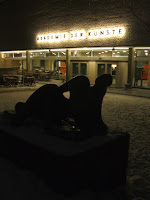 Akademie der Künste, Berlin
Akademie der Künste, BerlinThrough 8 February
This exhibit looks at the development of feminist performance art in the 1960s and 1970s, while an accompanying conference running 22-25 January looks at the resonance of the form today, with a series of talks and performances.
Visiting the exhibit last week, I spent about three hours there and could have stayed longer. The displays are not that elaborate but there is an impressive video archive of performances and some interviews, which bears careful perusal.
The film Not for Sale, by Laura Cottingham, gives a bit of context to the exhibit, offering a history of how performance art developed from the feminist movement and other social conditions in the United States. With protest in the air, it was only a matter of time before women put themselves at the centre of expression, using their bodies as inspiration and sometimes sites for creativity.
Of the many works in the archive, I was quite taken with DISBAND, a New York group of misfits, including Martha Wilson, Barbara Kruger and Diane Torr, who performed as a mock band in the early '80s, skewering machismo and US foreign policy with their songs and raps. Interesting that the members went off in such interesting directions afterward. Wilson will be speaking at the conference on moving from performer to archivist, as she now runs Franklin Furnace.
If the archival material is heavily informed by US performance art, the exhibit has a much more Germanic flavour. I was quite intrigued by the work of Gabriele Stötzer, who, moving from the punk scene to the art scene, formed the women's art group Exterra XX in the DDR in the '80s and fell foul of the authorities for her support of Wolf Biermann. Her video work and photos present alternative visions of female groups. Ewa Partum, originally from Poland but working in Germany, used her nude body as a way to protest against restrictions in society.
One theme of the exhibit is connecting past and present artists, and Stefanie Seibold's installation, A Reader-Wallpaper, offers a kind of summary in performance practice past and present. Her series of booklets, A Reader, presents an assemblage of influences from feminist theory to pop culture references, while monitors play performances by such artists as VALIE EXPORT from the De Appel archive.
Archiving and re-staging performances are two themes of the conference and Cornelia Sollfrank is currently staging several artists' works, including one of EXPORT's in which she takes a man on a dog lead for a walk through a shopping mall. This features in the video archive, while photos of re-stagings are showing in the exhibit. Her newest work re-imagines Valerie Solanas's SCUM Manifesto, which rather boggles the mind.
What relevance does the work of the '60s and '70s have today? Why re-stage? Where does feminist performance art go from here? All questions to be discussed at the conference.
No comments:
Post a Comment